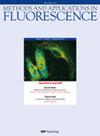荧光半胱氨酸探针基于一个信号放大单元,催化发夹组装反应和Förster共振能量转移
IF 2.4
3区 化学
Q3 CHEMISTRY, ANALYTICAL
引用次数: 0
摘要
这项工作开发了一种基于DNA的敏感荧光探针,该探针包括半胱氨酸结合单元和基于催化发夹组装(CHA)反应的信号放大单元。半胱氨酸结合单元包括富含胞嘧啶并通过银离子结合在一起的单链DNA(ssDNA)的同源二聚体。在半胱氨酸存在的情况下,同源二聚体由于半胱氨酸-银结合而分解,从而释放ssDNA,从而驱动信号放大单元中的CHA反应。Förster共振能量转移(FRET)用于报道扩增的双链DNA(dsDNA)产物的产生。在最佳条件下,该探针具有良好的线性(100–1200 nM)、良好的检测限(47.8±2.7 nM)和定量限(159.3±5.3 nM),以及良好的灵敏度(1.900±0.045μM−1)。随后,该探针被用于检测九个真实食品补充剂样品中的半胱氨酸。所有结果都提供了AOAC可接受的良好回收率,表明它具有实际应用的潜力。本文章由计算机程序翻译,如有差异,请以英文原文为准。
Fluorescent cysteine probe based on a signal amplification unit, a catalyzed hairpin assembly reaction and Förster resonance energy transfer
This work developed a sensitive DNA-based fluorescent probe comprising a cysteine binding unit and a signal amplification unit based on a catalyzed hairpin assembly (CHA) reaction. The cysteine binding unit comprises a homodimer of single-stranded DNA (ssDNA) rich in cytosine and held together by silver ions. In the presence of cysteine, the homodimer is disintegrated because of cysteine-silver binding that liberates the ssDNA, which drives the CHA reaction in the signal amplification unit. Förster resonance energy transfer (FRET) was used to report the generation of the amplified double-stranded DNA (dsDNA) product. Under the optimal conditions, the probe provided a good linearity (100–1200 nM), a good detection limit (47.8 ± 2.7 nM) and quantification limit (159.3 ± 5.3 nM), and a good sensitivity (1.900 ± 0.045 μM−1). The probe was then used to detect cysteine in nine real food supplement samples. All results provided good recoveries that are acceptable by the AOAC, indicating that it has potential for practical applications.
求助全文
通过发布文献求助,成功后即可免费获取论文全文。
去求助
来源期刊

Methods and Applications in Fluorescence
CHEMISTRY, ANALYTICALCHEMISTRY, PHYSICAL&n-CHEMISTRY, PHYSICAL
CiteScore
6.20
自引率
3.10%
发文量
60
期刊介绍:
Methods and Applications in Fluorescence focuses on new developments in fluorescence spectroscopy, imaging, microscopy, fluorescent probes, labels and (nano)materials. It will feature both methods and advanced (bio)applications and accepts original research articles, reviews and technical notes.
 求助内容:
求助内容: 应助结果提醒方式:
应助结果提醒方式:


